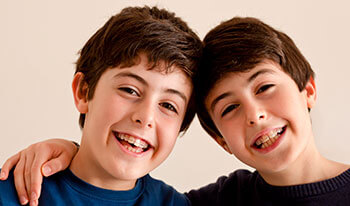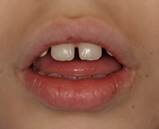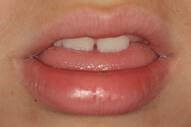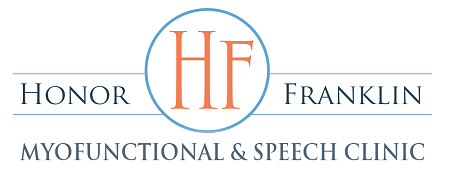Orofacial Myofunctional Disorder
or Tongue Thrust

What is an Orofacial Myofunctional Disorder (OMD) or “Tongue Thrust”?
Many of you may not be familiar with the term “Orofacial Myofunctional Disorder” often abbreviated as OMD. A more common term that has been used to describe an OMD is “tongue thrust”. A “tongue thrust” is the most recognizable, over-emphasized and misunderstood of the many OMDs.
A “tongue thrust” was defined as the improper placement of the tongue during the act of swallowing. The term “tongue thrust” although still commonly used today, has become antiquated because it implies incorrectly that the tongue is forcefully thrust forward during swallowing and thereby moves the teeth. A “tongue thrust” behavior pattern does not move the teeth because the duration of the pressure applied by the tongue against the teeth during a swallow (approximately an eighth of a second) is insufficient to move the teeth. Dental changes require a longer period (six hours or more) of light, continuous pressure to the dentition to affect dental changes. Research has shown that just as orthodontic braces can move the teeth with light, continuous pressure, the tongue resting against or between the teeth can also move the teeth with light, continuous pressure. So, it’s not the swallow that moves the teeth but it is the incorrect resting posture of the tongue that causes dental malocclusions.
“Tongue thrust” is now known as an incorrect tongue resting posture and incorrect swallowing pattern and it is the most common orofacial myofunctional disorder (OMD) and involves inappropriate muscle function and incorrect habits involving the tongue, lips and jaw.
Orofacial Myofunctional Disorders (OMDs) may include one or a combination of the following:
-
Incorrect tongue and lip resting posture consisting of an openmouth, low, forward resting position of the tongue against and between the teeth
-
Incorrect swallowing pattern consisting of the improper placement and function of the tongue during swallowing with the tongue thrusting in between, forward or sideways against the teeth (referred to in the past as “tongue thrust”)
-
Oral habits such as thumb, finger or pacifier sucking habits and other oral habits including fingernail biting, lip biting, lip licking, lip and tongue sucking habits.

What causes an Orofacial Myofunctional Disorder (OMD)?
Did you know that approximately 80% of patients who have an Orofacial Myofunctional Disorder (OMD) have a nasal airway interference problem and the other 20% usually have a detrimental habit such as thumb or finger sucking?
Most OMDs include one or a combination of factors that may include:
-
A nasal airway restriction from enlarged tonsils or adenoids, deviated septum, hypertrophied turbinates, etc. AND/OR allergies or anatomical deviations involving the nasal cavity or pharynx
-
Improper oral habits such as thumb, finger, tongue, lip sucking, a cheek or nail biting, teeth clenching or grinding
-
Habit and weak muscle strength
-
Structural or physiological abnormalities such as a shortened lingual frenum (tongue tie)
-
Hereditary predisposition to any of the above factors.
But the most common cause of OMDs are nasal airway problems. Therefore, patients with OMDs suspected of having airway interference issues are referred to an otolaryngologist (ENT) and Allergist, who are on Dr. Franklin’s team and are well versed in OMDs, to identify and treat nasal airway interferences prior to the initiation of OMT or sucking elimination therapy.

Why be concerned?
Orofacial Myofunctional Disorders (OMDs) can have a negative effect on the growth and development of the teeth and facial shape. Dental eruption patterns and dental alignment can be disrupted. These abnormal habit patterns, functional activities, and postures can open the dental bite beyond the normal rest position which can lead to a disruption of dental development in children and an over eruption of selected teeth in adults. OMDs can slow orthodontic treatment and it can undermine the stability of orthodontic treatment and/or jaw surgery resulting in a relapse orthodontically and/or surgically. The temporomandibular joint apparatus may become impaired or damaged from abnormal oral functional patterns.
Habitual open lips resting posture (lip incompetence), commonly found among individuals with OMDs, eliminates the beneficial influence that closed lips have on the development and maintenance of a good dental arch form and facial shape. Over time, dental malocclusion, cosmetic problems, and even changes in jaw growth and position are observed in some patients. Examples of changes that can result from a chronic openmouth rest posture include an increased vertical height of the face, a retruded chin, a downward and backward growth of the lower face (rather than downward and forward) and flaccid and hypotonic lips (Profft, 1986).
Children and even adults with incorrect chewing and swallowing patterns frequently chew food with their lips open, usually taking large bites and swallowing without completely chewing the food. This behavior often leads to food particles around the mouth, noisy chewing and swallowing (smacking and gulping) and a messy eating area. It can also cause an upset stomach from swallowing too much air.
Research has revealed a high instance of speech problems in those individuals who exhibit OMDs. The / s / sound is the most common. Others are / z /, / sh /, / ch /, / j /, / t /, / d /, / n /, / l /, and / r /. When there is a combination of OMD and related speech errors, it is often difficult to correct the speech problems through traditional articulation (speech) therapy alone.
It is important to understand that a lips together rest posture and a correct rest posture of the tongue is crucial to facilitate normal growth and development of the orofacial and dental structure.
What is Orofacial Myofunctional Therapy (OMT)?
Orofacial Myofunctional Therapy (OMT) is the treatment of Orofacial Myofunctional Disorders (OMDs).
Orofacial Myofunctional Therapy (OMT) is now referred to as rest posture therapy, not tongue thrust therapy.
Orofacial Myofunctional Therapy (OMT) treats a variety of oral and facial (orofacial) muscle (myo) postural and functional disorders and habit patterns that may disrupt normal dental development and also create cosmetic problems as well as speech problems. It involves an individualized regimen of exercises to retrain patterns of muscle function which influence dental occlusion, facial shape, chewing, swallowing, speech as well as tongue, lips, jaw and facial resting posture. Achieving a correct resting posture of the tongue, lips, jaw and face is the primary goal of OMT.
OMT is designed to not only retrain patterns of muscle function and to aid in the creation and maintenance of a healthy, adaptive orofacial environment but it can help in the retention of the dental and/or orthodontic treatment, in the enhancement of one’s appearance and in the maintenance of optimum dental health for a lifetime of benefits.
What are the goals of Orofacial Myofunctional Therapy (OMT)?
Restoring a normal resting posture of the tongue and lips and eliminating an incorrect swallowing pattern can:
-
Recapture the freeway space dimension by eliminating deleterious sucking habits, repositioning a forward resting tongue posture, teaching a closed lips, nasal breathing posture, retraining and eliminating an incorrect chewing pattern and swallow or normalizing (opening) a closed dental rest posture;
-
Guide the teeth into a more desirable relationship during the growth and development years;
-
Assist the orthodontist in aligning the teeth and jaws properly;
-
Assist stabilization of the teeth during and/or after orthodontic treatment or jaw surgery;
-
Eliminate or reduce the need for articulation (speech) therapy in many instances and/or remediate speech errors more quickly and long-term with traditional articulation (speech) therapy if you are a Licensed Speech-Language Pathologist;
-
Enhance overall facial appearance. Improving cosmesis with lips together rest posture is an important treatment goal.
What Age can Therapy begin?
We are all born with an Orofacial Myofunctional Disorder consisting of an incorrect resting tongue and lip posture and incorrect swallowing pattern which we should have outgrown by the time we are six, seven, or eight years of age and it should have transitioned into a normal resting tongue and lip posture and normal swallowing pattern.
Children as young as five can benefit from an evaluation or therapy to eliminate harmful sucking habits. The general rule in dentistry, and affirmed in pediatrics, is that oral habits should be addressed and eliminated prior to the eruption of the adult incisors, or by age six (Hanson and Mason, 2003). Without habit elimination, a maxillary posterior crossbite and an anterior openbite, or other malocclusions, will likely occur as well as speech errors.
Age five is also a good age to be evaluated to determine if there are causative factors that require prevention or intervention such as referring a patient for a medical evaluation of an airway interference issue. Children seven or eight are good candidates to receive some form of Orofacial Myofunctional Therapy.
Orofacial Myofunctional Therapy is also appropriate for adults. In many instances, an Orofacial Myofunctional Disorder develops in response to late jaw growth, worsening of malocclusion over time, or other reasons such as tooth loss. Therapy for adult patients is typically efficient. Adults of all ages are capable of achieving success in treatment.
How Effective is Orofacial Myofunctional Therapy (OMT)?
There are many factors that contribute to the success of the therapy program. It is truly a team effort. Effective communication and cooperation between therapists in the dental and medical community is essential. In addition, successful Orofacial Myofunctional Therapy depends on the patient’s desire, dedicated cooperation and self-discipline as well as support from others. To ensure optimum results for children undergoing therapy, parental involvement and encouragement is important and necessary.
Orofacial Myofunctional Therapy (OMT) has helped literally thousands of individuals in dozens of countries for over 40 years. Therapies have been shown to be effective and stable long-term. The most recent report of OMT results published by an IAOM-Certified Orofacial Myofunction® Therapist and Speech-Language Pathologist, JoAnn Smithpeter, and an orthodontist and department chair, Dr. David Covell, Jr. (American Journal of Orthodontic and Dental Facial Orthopedics, 2010) compares the relapse rate of orthodontic appliances with and without OMT. Results revealed that “OMT with orthodontic treatment was efficacious in closing and maintaining closure of dental openbites and angle Class I and Class II malocclusions, and it dramatically reduced the relapse of openbites in patients who have forward tongue posture and tongue thrust. Correcting low, forward tongue posture and tongue thrust swallows minimizes the risk of orthodontic relapse.”
A study done by Hahn and Hahn (1992) revealed that treatment for OMDs should be 80-90% effective in correcting rest posture, swallowing and other oral function and that these corrections are retained years after completing therapy.
There are a host of other studies to confirm that OMT is effective and stable long-term for the variety of conditions involved. Some selected evidence-based reports are included in the references compiled by Dr. Robert Mason under the heading “Efficacy and Treatment: Does Orofacial Myofunctional Therapy work?” in his article, “For Dentists and Physicians”.
Who Should Treat Orofacial Myofunctional Disorders (OMDs)?
Orofacial Myologists/Orofacial Myofunctional Therapists who are CERTIFIED by the International Association of Orofacial Myology (IAOM) have the appropriate training to provide treatment. The IAOM is a professional organization, founded in 1972, devoted to educating and certifying qualified Orofacial Myofunctional Therapists. The IAOM is the leader in Orofacial Myofunctional Therapy and is the ONLY international professional accrediting organization of this therapeutic specialty. Those members who have earned the credential of Certified Orofacial Myologist (COM)® have the appropriate training to identify and provide successful treatment for OMDs.
Since Dr. Franklin is a Licensed Speech-Language Pathologist, it is sometimes assumed all Speech-Language Pathologists are trained to treat OMDs. Unfortunately, this is not true. Only an IAOM-Certified Orofacial Myofunctional® Therapist is trained to correct OMDs. Dr. Franklin is both an IAOM-Certified Orofacial Myofunctional® Therapist and a Licensed Speech-Language Pathologist and has achieved the expertise and training to treat OMDs.
Dr. Franklin is always happy to work with dentists, orthodontists, and other doctors to ensure that patients’ needs are handled appropriately and they achieve the care they deserve. Our Dallas, TX office welcomes patients from nearby Park Cities, Highland Park, North Dallas, Plano, Rockwall, Mesquite, and beyond.
